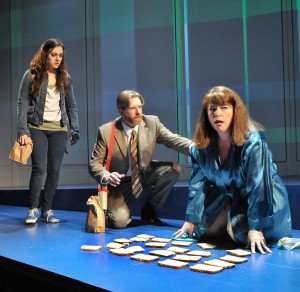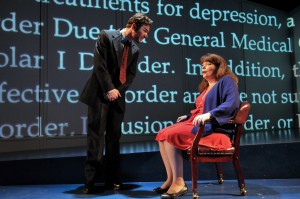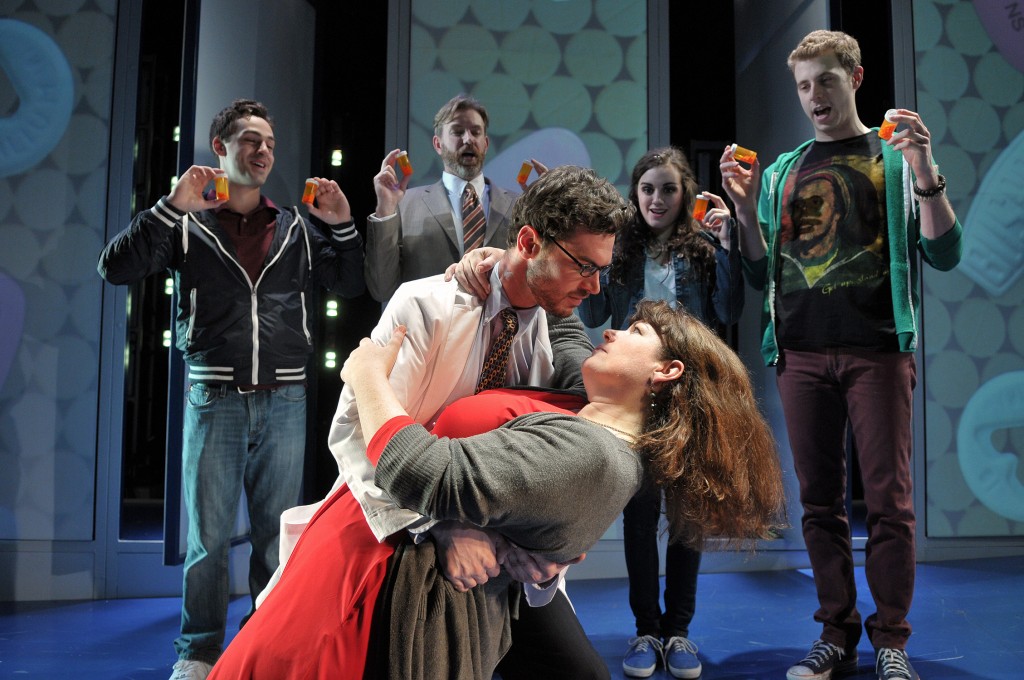Theater Review: “Next to Normal” Takes American Musicals Into the New Millennium
This musical’s challenging, raw, and poignant storyline, along with the stunning work of the SpeakEasy Stage Company cast and designers create a can’t-be-missed, far from normal production.
Next to Normal. Music by Tom Kitt. Book and Lyrics by Brian Yorkey. Directed by Paul Daigneault. Music Direction by Nicholas James Connell. Presented by SpeakEasy Stage Company, at Boston Center for the Arts, 539 Tremont Street, Boston, MA, through April 22.
By Alyssa Hall

Sarah Drake, Christopher Chew and Kerry A. Dowling in a scene from the SpeakEasy Stage Company production of Next to Normal. Craig Bailey/Perspective Photo.
Next to Normal, the brilliant winner of three Tony Awards and a Pulitzer Prize for Drama, boldly takes musicals into the modern age. The SpeakEasy Stage Company should be thanked for daring to tackle the show’s challenging subject matter and score, bringing it to Boston in a first-rate production.
On paper, the story doesn’t scream theatrical potential: it is a seemingly small-scale drama about a family—mother Diana, father Dan, daughter Natalie, and son Gabe—struggling to connect as they deal with Diana’s bipolar disorder. But given its dark and emotionally intense depths, tiny cast of six, original music and book, realistic setting, and ambiguous resolution, Next to Normal stands in proud opposition to the bloated musical norm: large scale spectaculars, cheery adaptations, jukebox shows, and comedy spectacles.
As Natalie experiences when she flees to her piano in distress, music is not only about uplift but can serve as an exquisite vehicle to explore pain and personal drama. Next to Normal’s world is yours or your coworker’s: a world where people can’t always heal or deal and don’t always get perfect endings, where families struggle with mental illness, grief, and trying to be “normal,” and where pain and comedy intermingle. The show’s success, as a piece of popular art, proves that room exists for musical dramas of a less epic nature than, say, Les Miserables, and that modern audiences do crave (and will pay to see) small-scale, complex, and less idealized stories that reflect contemporary themes.
At the talk-back after the performance, musical director Nicholas Connell noted how the composed-through, rock-infused score changes styles frequently and lacks defined song endings, its abrupt highs and lows mirroring the emotional elevator that Diana rides because of her bipolar disorder. From a performance standpoint, these mood shifts, lack of pauses between songs, and the demanding vocal ranges required in this over two-hour-long show make the lead roles extremely challenging.
Fortunately, Kerry A. Dowling is more than up to the demanding task of playing Diana; hers is a performance that should not be missed. She adroitly transitions between the manic and depressive sides of bipolar disorder, veering from blunt jokes at her own expense to sexual fantasies about her doctor as a rock star and heartbreakingly poignant personal revelations, as in “How Could I Ever Forget,” when she finally recalls a repressed tragic memory.
Dowling tackles everything musical, ranging from comedic homages to classic Broadway (“These are a few of my favorite pills”) and wistful jazz waltzes to angry high-energy rock numbers with scarcely a break. It is all intense, but the actress makes the high psycho-drama work, never letting it become melodramatic. In her hands, Diana stays a unique, individual person, not a mental disorder.
Sarah Drake contributes another powerhouse performance as Natalie, who turns to music then to drugs in order to cope with her family’s neglect. With her powerful voice, which can sound a harsher note of anger and desperation when needed, Drake makes for a compelling and sympathetic genius teen whose tortured story often parallels Diana’s.

Chris Caron and Kerry A. Dowling in a scene from the SpeakEasy Stage Company production of Next to Normal. Craig Bailey/Perspective Photo
The male actors don’t burn quite as brightly next to these two performances, but they also portray weaker characters with admirable skill. Christopher Chew’s Dan, the husband/father trying to hold his family and marriage together, tightly contains and suppresses displays of pain or vulnerability. This is a valid acting choice for the character, whom Diana describes as “boring” and who stubbornly insists on pretending everything is “gonna be good,” but a slightly more physically expressive articulation of his tamped down emotions would be a much more satisfying match for the rich expressiveness of Chew’s voice.
Michael Levesque’s portrayal of Henry, Natalie’s pot-head boyfriend, suffers from a similar weakness, but with less justification. Henry may be mellow to a fault, but he must be passionate about Natalie or his devotion to her throughout her downward spiral doesn’t make much romantic sense. Here he comes across as tentative and bland, a portrayal that is not helped when he has trouble hitting the high notes in his songs and his slightly-off delivery of comic lines that should get a lot more laughs.
Michael Tacconi as Gabe has no difficulty with physical expressiveness or tentativeness. His character swaggers and jumps about the stage with virile teenage boy entitlement, his smooth voice aptly seductive or faintly menacing and desperate as necessary. The Dr. Fine/Dr. Madden characters serve as plot devices that explain and plan Diana’s treatments, but Chris Caron’s strong voice and his excellent ensemble work with the others round out the capable cast nicely.
The production’s designers create a vibrant, modern, and minimalistic environment for the actors that suit the show’s high intensity and its focus on inner life rather than scenery. Scenic designer Eric Levenson uses a few easily moveable props to facilitate quick changes and to keep the two-level stage uncluttered (allowing movement across the entire space). The minimal use of props focuses attention on the clever main set piece: a wall of tall, white, rectangular panels at the back of the stage that swing open to allow a variety of entrance options while also providing a canvas for the savvy use of visual projections.
On the whole, the projections are a perfect choice, able to change as instantly as Diana’s moods, serving as screens for images that capture hectic emotions, such as what flickers though Diana’s mind during her shock treatment. Projection designer Seághan McKay inserts a few head-scratchers: a green plaid wall pattern doesn’t look relevant, along with wallpaper and a row of huge school lockers that are too cartoony, literal, and unnecessary.

Chris Caron and Kerry A. Dowling. Rear from Left: Michael Tacconi, Christopher Chew, Sarah Drake, and Michael Levesque in a scene from the SpeakEasy Stage Company production of Next to Normal. Craig Bailey/Perspective Photo
Most of the projections add depth to the show, however. The text of medical definitions that loom in Dr. Madden’s office raise questions about whether he is treating the person or the symptoms. In another scene, a live camera captures Diana’s blinking eyes as she is hypnotized on stage, projecting them onto a sea of mist. More subtly, large Victorian vines crawl across the walls of the sitting room, where several important revelations and emotional breakdowns occur, conjuring up “The Yellow Wallpaper,” one of the earlier attempts at exploring female mental illness in literature.
For the most part, the vibrant lighting by Jeff Adelberg complement the contemporary feel of the scenic and projection designs. He makes a lovely choice to use a soft light in a lampshade suspended over a chair for scenes when Dan and Diana have their break downs. It makes the experiences even more intimate and startling.
Although Next to Normal is not a ‘mental illness musical’ (bipolar disorder is one of the several challenges within a bigger story), a commitment to a realistic interpretation of the illness is essential, both out of respect for those coping with it and those who may form impressions of the condition based on the show. SpeakEasy Stage seizes on this commitment by having cast members meet with real couples in similar situations for the purpose of research and by partnering with the National Alliance on Mental Illness to promote educational opportunities such as doctor talkbacks after Saturday matinee performances.
This admirable connection of theater with the real world, taken with the challenging, raw, and poignant storyline and stunning work of the SpeakEasy Stage cast and designers, creates a can’t-be-missed, far from normal production.
